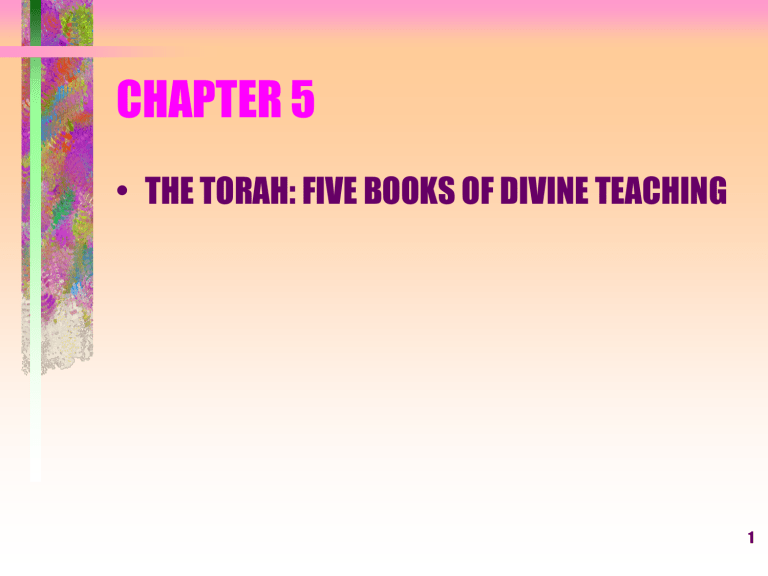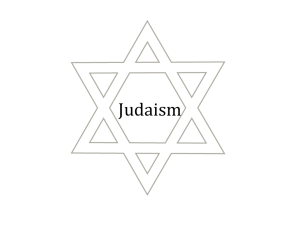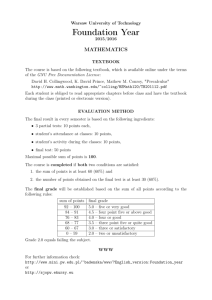See Textbook

CHAPTER 5
• THE TORAH: FIVE BOOKS OF DIVINE TEACHING
1
See Textbook :
S. L. Harris, Understanding the Bible . Seventh Edition, pp.
86-143.
2
Five Books of Divine Teaching/Torah/Pentateuch :
- Contains the law or divine teaching that Yahweh gave to Israel through Moses:
Genesis ;
Exodus ;
Leviticus ;
Numbers ; and
Deuteronomy .
3
Exodus :
- The heart of the Torah;
- Tells the story of how Yahweh rescued Israel from slavery in Egypt, led them to Mount Sinai, and bound
Israel to himself in a sacred covenant;
- In return, Israel promises to recognize Yahweh only as
God and to do all that Yahweh commands (Exod 20.1-
6);
- The Mosaic Covenant ;
- Yahweh is the hero of the Book of Exodus and, in fact, the rest of the Torah.
4
5
I .
Who Wrote the “Books of Moses”? (Textbook, pp. 87-
103)
Difficulties with positing Moses as the author of the Torah;
6
DOCUMENTARY HYPOTHESIS (see pp. 89-95) :
J (YAHWIST);
E (ELOHIST);
D (DEUTERONOMIST); and
P (PRIESTLY WRITER);
- R. E. FRIEDMAN, WHO WROTE THE BIBLE? 1987 .
7
DOCUMENTARY HYPOTHESIS (contd.):
Four main sources for the Pentateuch/Torah:
- The YAHWIST (J); begins with Story of Creation, Gen 2.4b-
25;
ELOHIST (E); begins with the Story of Abraham;
DEUTERONOMIST (D); especially the Book of
Deuteronomy; and
PRIESTLY DOCUMENT (P); begins with a Story of
Creation (Gen 1.1-2.3) in six days and rest on the seventh.
- The Books of the Torah/Pentateuch have multiple authorship and a long history of editorial revisions;
8
The Pentateuch’s final redactor/editor skillfully integrated JE,
D, and P into a rich narrative;
(SEE J. H. HAYES, INTRODUCTION TO THE BIBLE , Chart
7, p. 245.)
9
THE DEUTERONOMISTIC HISTORY:
The narrative books of JOSHUA to KINGS ;
- composed during the time of JOSIAH (640-609 B.C.E.)
10
The PROPHETS, e.g., ISAIAH, JEREMIAH:
- collections of saying not written down immediately but collected by literate disciples of the prophets at a later date;
11
THE WRITINGS ( KETHUVIM ):
- an anthology of post-exilic (after 538 B.C.E.) Hebrew literature;
12
Binding Element in the Torah/Pentateuch :
- Yahweh’s unsolicited promises to Abraham and Sarah;
Isaac and Rebekah, and Jacob and Rachel (and Leah);
- The divine promises are grouped together in Genesis
12-50:
Six components :
- Yahweh vows to give Abraham and/or his grandson Jacob: 1) a son; 2) descendants; 3) his presence; 4) land; 5) blessing; and 6) covenant.
(See Textbook, pp. 96-98.)
13
The divine promises shape not only the
Pentateuch’s general structure but also the Deuteronomistic History that follows;
( Deuteronomistic History : Joshua; Judges; 1 and 2
Samuel; and 1 and 2 Kings ( The Former Prophets ) - we will do this later.)
14
Some Literary Forms/Genre in the Torah/Pentateuch
(See Textbook, pp. 98-101) :
- Narrative;
- Etiology;
- Itinerary;
- Genealogy;
- Cult Legend; and
- Legal Codes.
15
Questions :
1. Do the five “Questions for Review” on pp. 101-102 in the
Textbook.
2. Do the two “Questions for Discussion and Reflection” on p. 102 of the Textbook.
3. Please pay attention to “Terms and Concepts to
Remember on p. 102.
16
II. Genesis (pp. 103-117) :
- The book is organized into three general parts:
- 1) Chs. 1-11: primeval history;
- 2) Chs. 12-36: Patriarchal and Matriarchal stories;
- 3) Chs. 37-50: the story of Joseph and his brothers;
- The book begins with the creation of the world and ends with the Israelites, few in number and settled in Egypt, far from their Promised Land.
17
1) The Primeval History (Genesis 1-11):
- Read Gen 1.1-2.4a: Priestly account of creation;
- Read Gen 2.4b-25: Yahwistic account of creation.
- The Priestly account of creation and Enuma Elish ( pp. 39,
60, 73, 78 in Textbook)
- A comparison of the Priestly and Yahwistic accounts of creation.
- See Figure 5.2 (p. 105 in Textbook): an artistic re-creation of the ancient biblical view of the universe.
18
- Read Gen 6.5-8.22: The Composite J-P Flood Story;
(See Box 3.1 “Excerpts from the Mesopotamian Flood Story
In the Gilgamesh Epic,
” pp. 52-53 in Textbook);
The Flood Story, pp. 107-108 in Textbook.
19
Genesis 9 :
- Presents the postdiluvian world as a new beginning for humanity (compare Gen 1.28 with 9.7);
- God institutes the first of the Biblical Covenants (see
“Covenant”, G-9);
- The Covenant with Noah and his descendants is universal and it includes all humans Gen 9.8-17);
Gen 10.1-32 : the Table of Nations:
- The genealogies of Noah’s three sons, Shem , Ham , and
Japheth ;
- A background of world history for the call of Abraham
(Genesis 12).
20
2)
Stories of the Patriarchs and Matriarchs/Israel’s
Ancestors (Genesis 12-36):
- The cycle of disparate tales involving the Patriarchs and the Matriarchs is unified by the theme of God’s promises
(see, Textbook, pp. 108-112; for promises see pp. 96-98).
- Abraham and Sarah;
- Isaac and Rebekah;
- Jacob and Rachel (and Leah).
21
The Ancient Near East.
22
23
24
25
-
Abraham’s
Call and Migration (Gen 11.27-12.9)
- Abraham and Hagar and their Son Ishmael (Genesis 16);
- Abraham and Sarah and the birth of Isaac (Gen 18.1-15,
21.1-8);
- Abraham’s debate with God: the cities of Sodom and
Gomorrah (Gen 18.16-19.29);
- Lot and his daughters and the birth of Moab and Ammon
(Gen 19.30-38);
26
Gen 18.16-19.29:
Sodom and
Gomorrah;
Gen 19.30-38:
Birth of Moab and
Ammon.
27
Church of St. George in Jordan in which the Madaba Mosaic Map is located
28
Madaba Mosaic Map
29
- Isaac and Rebekah (Genesis 24);
- Birth of Esau and Jacob (Gen 25.19-26);
- Jacob will become the father of the Twelve Tribes of Israel ;
- Esau is Edom (Gen 25.30).
30
31
32
- Jacob and Rachel (and Leah):
- Jacob and Leah (Gen 29.23-25);
- Jacob and Rachel (Gen 29.28);
- and the handmaids:
- Bilhah (Gen 30.1-8); and
- Zilpah (Gen 30.9-13);
- Jacob’s 11 sons (Gen 29.31-30.24) and Benjamin (35.16-
18);
- The 12-Tribe Pattern of the Israelite Confederacy;
- and God’s Promises (See Textbook, pp. 96-98)?
33
3) Joseph and His Brothers (Genesis 37-50):
- Joseph in Egypt.
The Book of Genesis begins with the creation of the world and ends with the Israelites, few in number and settled in
Egypt, far from their Promised Land.
34
35
Do “Questions for Review”, pp. 115-116, and “Questions for
Discussion and Reflection” on p. 116 of Textbook;
Pay attention to “Terms and Concepts to Remember”, p. 116.
36
III. Exodus :
- The promises (see pp. 96-98 in Textbook) to Abraham begin to be fulfilled.
- Outline:
1) Hebrews in Egypt (Ch. 1);
2) Story of Moses (Chs. 2-6);
3) Yahweh’s war against Pharaoh and the institution of the
Passover (chs. 7-13);
4) The miraculous sea crossing and desert wanderings (Chs.
14-18);
5) The Sinai theophany and ratification of the Mosaic
Covenant (Chs. 19-24, 32-34);
37
6) Instructions for the Tabernacle Cult (Chs. 25-31, 35-40).
See map in Textbook, Fig. 5.6, p. 125.
38
39
- The problem of historicity of the events described in
Exodus (see Textbook, pp. 118-119).
- Literary sources of Exodus (see Textbook, p. 119):
- the Yahwist;
- the Elohist;
- the Priestly; and even
- the Deuteronomist strands are interwoven.
40
Read in the Book of Exodus :
- The theophany of the bush (3.1-6);
- Yahweh, the divine name (3.13-15; 6.2-4);
- The divine commission (3.7-12);
- The theophany at Sinai (19.1-25);
- The Ten Commandments (20.1-17);
- The Covenant Code (20.22-23.33);
- See especially, 23.10-29: A Cultic Calendar; and
- The conclusion of the Covenant (23.20-33).
41
42
St. Catherine’s Monastery at the foot of Mount
Sinai.
43
Saint Catherine’s Monastery at Mount
Sinai.
44
Steps leading from St. Catherine’s
Monastery to the top of Mount Sinai.
45
Church of the Holy Trinity at the Peak of Mount
Sinai.
46
Cultic Calendar (23.10-19):
• V. 12: The Observance of the Sabbath;
• V. 14: Three Festivals:
• V. 15: Feast of Unleavened Bread ;
• V. 16: The Festival of Harvest, that is, the Festival of
Weeks or Pentecost ;
• V. 16: The Festival of Ingathering or the Festival of
Booths .
• (See Exodus 34.18-26; Lev 23.1-44; Deut 16.1-17).
47
- See map in Textbook, Figure 5.6, p. 125: possible routes of the Hebrews across the Sinai Peninsula, from Egypt to the
Promised Land.
48
49
Questions on Exodus, pp. 128-129 in Textbook :
Do Questions 1, 2, 5, 7, and 8 plus:.
2. What is the connection between the tenth plague, the angel of death, and the Passover meal? How does
Yahweh rescue Israel at the Great Sea?
4. Describe clearly the contents of the “Cultic Calendar” of
Exodus 23.10-19.
5. Why does Exodus contain two distinct versions of the revelation of the Divine name to Moses (Exodus 3 and
6)?
“Questions for Discussion and Reflection”, p. 119, and
“Terms and Concepts To Remember”, p. 129.
50
IV. Leviticus (Textbook, pp. 130-133) :
- A collection of legal and liturgical material;
- The book was probably assembled during and shortly after the Babylonian Exile (587-538 B.C.E.);
- These rituals and legal stipulations belong almost exclusively to the priestly document;
- By observing these rituals and laws, the Israelite people will remain distinct and different from the Gentile nations that endeavour to absorb them.
51
Outline of the Book of Leviticus :
- 1) Laws dealing with sacrifices (Chs. 1-7);
- 2) The consecration of the priests to their office (Chs. 8-
10);
- 3) Laws setting forth the distinction between clean and unclean food (Chs. 11-15);
- 4) The Ceremony of the Annual Day of Atonement (Ch.
16);
- 5) Laws to govern Israel’s life as a Holy People (Chs. 17-
26); and
- 6) an Appendix on religious vows (Ch. 27).
52
Read :
-11.1-47: clean and unclean food (dietary stipulations):
- vv. 2-8, 26-27: land animals;
- vv. 9-12: those that live in the water;
- vv. 13-19: birds;
- vv. 20-23: winged insects;
- vv. 29-38, 41-45: those that swarm on the ground.
- The non-eating and non-touching of the unclean creatures;
- v. 47: distinguish between the clean and the unclean; between those that may be eaten and those that may not be eaten.
53
Read :
16.1-34: The Ritual for the Day of Atonement ( Yom
Kippur ):
- vv. 1-5: preparatory instructions;
- vv. 6-10: a short version of the ritual;
- vv. 11-28: a more elaborate version of the Ritual of Atonement:
- vv. 11-14: for the priests;
- vv. 15-22: for the people;
- vv. 20-22: the scapegoat;
- vv. 23-28: contact with holiness;
- v. 29: the fast (the only one prescribed in the Mosaic law).
54
Leviticus 23.1-44 (The Sacred Calendar) (compare with
Exodus 23.10-19; Exodus 34.18-26; and Deut 16.1-17):
• Trumpets shall announce the appointed festivals (v. 2);
• The Passover and the Festival of Unleavened Bread
(vv. 5-8);
• The offering of the First Fruits (vv. 9-14);
• The Festival of Weeks/Pentecost (vv. 15-21);
• The Festival of Trumpets or New Year (vv. 23-25);
• The Day of Atonement (vv. 26-32);
•The Festival of Booths or Thanksgiving (vv. 33-36, 39-
43).
55
Leviticus :
•25.1-55: The Sabbatical Year and The Year of Jubilee
(see Box 5.9, p. 131 in Textbook).
56
Blowing the Shofar.
57
Blowing the Shofar.
58
A collection of Shofars.
59
Read :
- Chapter 26: Blessings and Curses.
60
Questions on the Book of Leviticus :
1. Discuss the Book of Leviticus under the headings: 1) the probable time when it was “put’ together; 2) the main source; and 3) why these legal and liturgical stipulations.
2. Discuss the dietary laws of Lev 11.1-47.
3. Describe the ritual for the “Day of Atonement” of Lev
16.1-34;
4. Describe the Sacred Calendar of Lev 23.1-44.
5. Compare Lev 23.1-44 (“Sacred Calendar”) with Ex
23.10-19 (“Cultic Calendar”).
61
V. Numbers (Textbook, pp. 133-136) :
- A partial account of Israel’s 40-year wandering in the Sinai wilderness;
- A transitional work that links Yahweh’s revelation of the
Torah at Mt. Sinai to Israel’s long journey to Canaan;
- Preparation for taking possession of the Promised Land;
- The thematic unity in the book comes from emphasizing the importance of submitting to Yahweh’s governing arrangements and ethical directions.
62
63
- Only a fully obedient Israel can expect to enjoy a consummation of Divine Promises.
- The book takes its title from its Greek name, Arithmoi , that is, “Census” or “Numbering” of the people (Numbers 1-4);
- Hebrew title is Bemidbar
, meaning “in the wilderness”;
- Literary genres: genealogies, laws, rituals, legends, poetry, and narrative;
- The book points out that the people fail to appreciate the law Yahweh has given them or to cooperate with his appointed leader Moses.
64
Outline of the Book of Numbers :
- 1) Israel’s burgeoning population and additional laws (Chs.
1.1-10.10);
- 2) Israel’s itinerary as it makes its way from desert camp to desert camp (Chs. 10.11-36.13) until it reaches the Plains of
Moab (across from Jericho);
- 3) Yahweh allocates specific territories to tribal leaders (Ch.
34);
- 4) Cities of Refuge for certain criminals (Ch. 35).
65
66
Numbers (contd.):
- Israel’s rebellion and Yahweh’s anger:
- The people are rebellious;
- They complain;
- They are cowardly;
- They are ungrateful;
- Yahweh threatens to destroy them;
- Moses acts as a mediator;
- A challenge to Moses’ leadership.
- The depiction of Yahweh in Numbers (see Textbook pp.
135-136).
67
Question :
1. Discuss the Book of Numbers under the headings: a) in what way is it a transitional work; b) its thematic unity; 3) the itinerary; 4) the depiction of the people of Israel; 5)
Moses’ position; and 6) depiction of Yahweh.
68
VI. Deuteronomy (see Textbook, pp. 136-143) :
- Cast in the form of Moses’ three farewell speeches to a new generation of Israelites poised to enter the Promised Land;
- Moses speaks directly to the people shortly before his death;
- The site is the “plains of Moab” opposite Jericho and east of the Jordan River;
- 1) Chs. 1-4: Moses’ review;
-2) Chs. 5-26, 28: Second speech;
- 3) Ch. 27: the ceremonies at Shechem; and
- 3) Chs 29-30: the “two ways” (read: 30.15-20).
69
Chapter 27: A Covenant renewal ceremony at Shechem .
70
Shechem: modern village of
Nablus/Neapolis.
71
The Book of Deuteronomy, in its literary history and origin, has little to do with the JE narratives that precede;
In style and theological outlook, the book actually belongs to the historical books that follow it (that is, the
Deuteronomistic History [DH] ).
We will do later: The Deuteronomistic History: Joshua,
Judges, 1 and 2 Samuel, and 1 and 2 Kings.
72
Moses’ Speeches
:
1) First Speech (Chs. 1.1-4.43):
- a reminder to a new generation of Israelites;
2) Second Speech (Chs. 5-26, 28):
- expanded version of the Decalogue (5.6-21);
- the Shema (6.4-9);
- the deuteronomistic code (chs. 12-26);
3) Third Speech (Chs. 29-30):
- sufferings that will befall Israel if it sins;
- repentance and forgiveness and restoration.
73
Chs. 5-26: Moses’ Second Speech :
- This speech comprises the bulk of Deuteronomy ;
- includes an expanded version of the Decalogue/
“The Ten Commandments” (5.1-26);
- read this segment with special emphasis on the
Shema (6.4-9) (see Box 5.10, p. 140 in Textbook);
- The lex talionis (law of retaliation) (see Box 5.11, p. 141 in Textbook);
Deuteronomy’s position in the Pentateuch.
74
Deuteronomy provides a criterion by which to interpret
Israel’s national successes and failures:
Obedience to the Mosaic Torah ensures prosperity and divine protection;
Disobedience brings national defeat and death;
See Deut. 28.1-68; see also Deut. 30.10-20.
- Emphasizes of Deuteronomy:
- Social justice, personal ethics, and neighbourly responsibilities.
75
-
Josiah’s Reform and the Book of Deuteronomy (See
Textbook, Table 3.1, “Some Major Events …” , pp. 42-44);
Shema
: classic definition of Israel’s essential faith (Deut
6.4-9) (see pp. 139-141 in Textbook);
Lex Talionis : Deut 19.21 (See Box 5.12, p. 141);
- The Deuteronomic Hypothesis of History:
- Israel’s future is totally conditional on the
Israelites’ collective religious behaviour (see,
Textbook, p. 141);
76
Mezuza
77
Phylacteries
78
Phylacteries
79
- Moses’ last days and death: an unfilled career (Deut 34.10);
- Moses’ death - at the age of 120 - and his burial “in a valley in the land of Moab” (Deut 34.5-6).
80
81
Plains of Moab – Mount Nebo in the distance.
82
Plains of Moab – looking NW from Mount Nebo 83
Mount Nebo – Summit.
84
Franciscan Church at Mount Nebo.
85
Pope John Paul II praying at Mount Nebo in 2000.
86
Questions :
Three Questions on pp. 142-143;
Question 2 of “Questions for Discussion and Reflection” on p. 143.
”Terms and Concepts to Remember”, p. 143.
Torah (Divine Teaching)/ Pentateuch is now completed!
PEACE!
87



